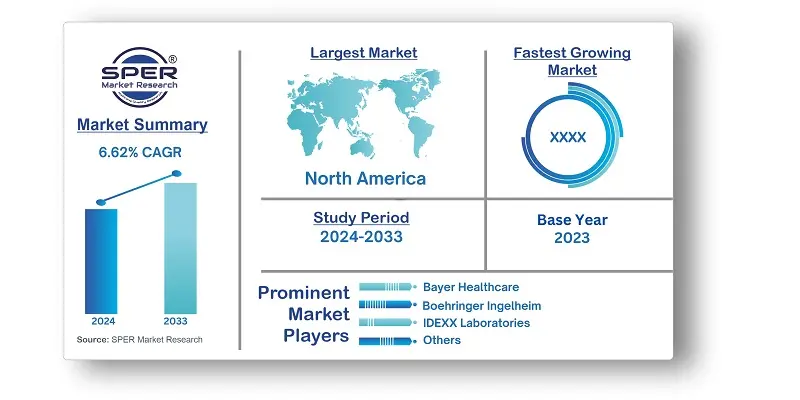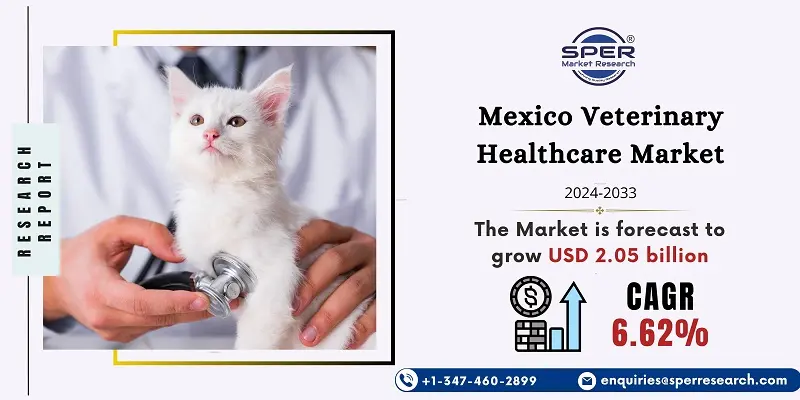
Mexico Veterinary Healthcare Market Trends, Share, Size, Revenue, Demand and Future Outlook
Mexico Veterinary Healthcare Market Growth, Size, Trends Analysis- By Product, By Animal Type, By Service Type, By End User– Regional Outlook, Competitive Landscape, Market Opportunities and Future Trends Forecast to 2033
| Published: Oct-2024 | Report ID: HLCA2481 | Pages: 1 - 108 | Formats*: |
| Category : Healthcare | |||
- In May 2022, Kemin Industries opened new facilities in Mexico to support Kemin Animal Nutrition and Health, Kemin Pet Food and Rendering Technologies, and Kemin Food Technologies.
- In April 2021, Avimex, a veterinary pharmaceutical business, produced a safe and efficacious COVID-19 vaccine based on recombinant Newcastle Disease Virus.


| Report Metric | Details |
| Market size available for years | 2020-2033 |
| Base year considered | 2023 |
| Forecast period | 2024-2033 |
| Segments covered | By Product, By Animal type, By Service Type, By End User. |
| Regions covered | Northeast, Midwest, South, West. |
| Companies Covered | Bayers Healthcare, Boehringer Ingelheim, Cave Animal Health Inc, Elance, IDEXX Laboratories, Merck Co. Inc, Phibro Animal Health. |
- Pet Owners
- Live-Stock Farmers
- Animal Shelter and Rescue Organization
- Veterinary Clinics and Hospitals
- Zoos and Wildfire Result
- Research Institute
| By Product: | |
| By Animal Type: | |
| By Service Type: | |
| By End User: |
- Mexico Veterinary Healthcare Market Size (FY’2024-FY’2033)
- Overview of Mexico Veterinary Healthcare Market
- Segmentation of Mexico Veterinary Healthcare Market By Product (Therapeutics and Diagnostics)
- Segmentation of Mexico Veterinary Healthcare Market By Animal Type (Dogs and Cats, Horses, Ruminants, Swine, Poultry and Others)
- Segmentation of Mexico Veterinary Healthcare Market By Service Type (Surgery, Grooming, Vaccination, Diagnostics Test, and Physical Health Monitoring)
- Segmentation of Mexico Veterinary Healthcare Market By End User (Pet Owner, Livestock, Animal Shelter, Veterinary Hospital, Zoos and Wildfire, Research Institution)
- Statistical Snap of Mexico Veterinary Healthcare Market
- Expansion Analysis of Mexico Veterinary Healthcare Market
- Problems and Obstacles in Mexico Veterinary Healthcare Market
- Competitive Landscape in Mexico Veterinary Healthcare Market
- Impact of COVID-19 and Demonetization on Mexico Veterinary Healthcare Market
- Details on Current Investment in Mexico Veterinary Healthcare Market
- Competitive Analysis of Mexico Veterinary Healthcare Market
- Prominent Players in Mexico Veterinary Healthcare Market
- SWOT Analysis of Mexico Veterinary Healthcare Market
- Mexico Veterinary Healthcare Market Future Outlook and Projections (FY’2024-FY’2033)
- Recommendations from Analyst
1.1. Scope of the report1.2. Market segment analysis
2.1. Research data source
2.1.1. Secondary Data2.1.2. Primary Data2.1.3. SPER internal database2.1.4. Premium insight from KOLs
2.2. Market size estimation
2.2.1. Top-down and Bottom-up approach
2.3. Data triangulation
4.1. Driver, Restraint, Opportunity and Challenges analysis
4.1.1. Drivers4.1.2. Restraints4.1.3. Opportunities4.1.4. Challenges
4.2. COVID-19 Impacts of the Mexico Veterinary Healthcare Market.
5.1. SWOT Analysis
5.1.1. Strengths5.1.2. Weaknesses5.1.3. Opportunities5.1.4. Threats
5.2. PESTEL Analysis
5.2.1. Political Landscape5.2.2. Economic Landscape5.2.3. Social Landscape5.2.4. Technological Landscape5.2.5. Environmental Landscape5.2.6. Legal Landscape
5.3. PORTERs Five Forces
5.3.1. Bargaining power of suppliers5.3.2. Bargaining power of buyers5.3.3. Threat of Substitute5.3.4. Threat of new entrant5.3.5. Competitive rivalry
5.4. Heat Map Analysis
6.1. Mexico Veterinary Healthcare Market Manufacturing Base Distribution, Sales Area, Product Type6.2. Mergers & Acquisitions, Partnerships, Product Launch, and Collaboration in Mexico Veterinary Healthcare Market
7.1. Mexico Veterinary Healthcare Market Size, Share and Forecast, By Product, 2020-20267.2. Mexico Veterinary Healthcare Market Size, Share and Forecast, By Product, 2027-20337.3. Therapeutics
7.3.1. Vaccines7.3.2. Parasiticides7.3.3. Anti-infectives7.3.4. Medical Feed Additives7.3.5. Other Therapeutics
7.4. Diagnostics
7.4.1. Immunodiagnostics Tests7.4.2. Molecular Diagnostics7.4.3. Clinical Chemistry7.4.4. Other Diagnostics
8.1. Mexico Veterinary Healthcare Market Size, Share and Forecast, By Animal Type, 2020-20268.2. Mexico Veterinary Healthcare Market Size, Share and Forecast, By Animal Type, 2027-20338.3. Dogs and Cats8.4. Horses8.5. Ruminants8.6. Swine8.7. Poultry8.8. Other Animals
9.1. Mexico Veterinary Healthcare Market Size, Share and Forecast, By Service Type, 2020-20269.2. Mexico Veterinary Healthcare Market Size, Share and Forecast, By Service Type, 2027-20339.3. Physical Health Monitoring9.4. Surgery9.5. Diagnostic Test and Imagining9.6. Artificial Insemination9.7. Grooming9.8. Vaccination
10.1. Mexico Veterinary Healthcare Market Size, Share and Forecast, By End User, 2020-202610.2. Mexico Veterinary Healthcare Market Size, Share and Forecast, By End User, 2027-203310.3. Pet Owner10.4. Livestock Farmers10.5. Animal Shelter and Rescue Organization10.6. Veterinary Hospitals and Clinics10.7. Zoos and Wildlife Reserve10.8. Research Institution
11.1. Mexico Veterinary Healthcare Market Size and Market Share
12.1. Mexico Veterinary Healthcare Market Size and Market Share By Region (2020-2026)12.2. Mexico Veterinary Healthcare Market Size and Market Share By Region (2027-2023)12.3. Northeast12.4. Midwest12.5. South12.6. West
13.1. BAYERS HEALTHCARE
13.1.1. Company details13.1.2. Financial outlook13.1.3. Product summary13.1.4. Recent developments
13.2. BOEHRINGER INGELHEIM
13.2.1. Company details13.2.2. Financial outlook13.2.3. Product summary13.2.4. Recent developments
13.3. CAVE ANIMAL HEALTH INC
13.3.1. Company details13.3.2. Financial outlook13.3.3. Product summary13.3.4. Recent developments
13.4. ELANCO
13.4.1. Company details13.4.2. Financial outlook13.4.3. Product summary13.4.4. Recent developments
13.5. IDEXX LABORATORIES
13.5.1. Company details13.5.2. Financial outlook13.5.3. Product summary13.5.4. Recent developments
13.6. MERCK CO. INC
13.6.1. Company details13.6.2. Financial outlook13.6.3. Product summary13.6.4. Recent developments
13.7. Phibro Animal health
13.7.1. Company details13.7.2. Financial outlook13.7.3. Product summary13.7.4. Recent developments
13.8. Virbac
13.8.1. Company details13.8.2. Financial outlook13.8.3. Product summary13.8.4. Recent developments
13.9. ZOETICS INC
13.9.1. Company details13.9.2. Financial outlook13.9.3. Product summary13.9.4. Recent developments
13.10. Others
SPER Market Research’s methodology uses great emphasis on primary research to ensure that the market intelligence insights are up to date, reliable and accurate. Primary interviews are done with players involved in each phase of a supply chain to analyze the market forecasting. The secondary research method is used to help you fully understand how the future markets and the spending patterns look likes.
The report is based on in-depth qualitative and quantitative analysis of the Product Market. The quantitative analysis involves the application of various projection and sampling techniques. The qualitative analysis involves primary interviews, surveys, and vendor briefings. The data gathered as a result of these processes are validated through experts opinion. Our research methodology entails an ideal mixture of primary and secondary initiatives.



Frequently Asked Questions About This Report
PLACE AN ORDER
Year End Discount
Sample Report
Pre-Purchase Inquiry
NEED CUSTOMIZATION?
Request CustomizationCALL OR EMAIL US
100% Secure Payment






Related Reports
Our Global Clients
Our data-driven insights have influenced the strategy of 200+ reputed companies across the globe.






















